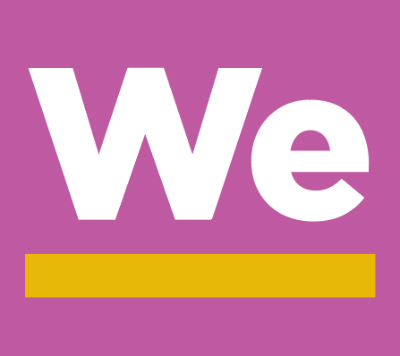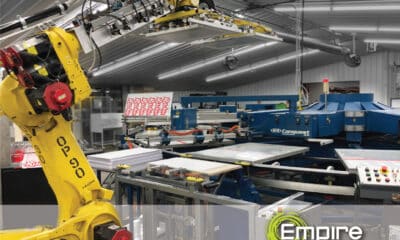
cross-train as many people as we can. It helps build the team environment and can encourage and allow others to step in and help. We pair new employees with a “veteran” to train.
To fully understand how we benefit from cross-training, you have to start with the hiring process. We hire based on attitude and personality to fit the culture: hard work, hard fun, and accountability. You can teach the skills; you can’t teach a personality. We focus on team and avoid, at all costs, the “it is not my job” people.
When a new hire comes in, they’re matched with a mentor. The intent is to teach the skill, i.e., printing or embroidery. They start with the basics and move from there as comfort levels expand. There’s more involved in this than pulling a squeegee. The time in the process is driven by the new employee. I’ve had some working on their own as soon as the first day.
We offer screen printing, screened numbers, embroidery, label changing, folding/bagging, vinyl names, etc. We have primary people in all these functions as well as unpacking/staging and shipping. All garments are verified as soon as they arrive and again before they leave. Just getting garments ready to get to the press can be overwhelming at times. We currently have around 25 employees. We started this business late May of 2020 – yes, the COVID year.
As one area of production begins to show a backlog, we shift others to this area to free a potential backup before it happens. This often allows for the needed time to train, not just help. All of my printers can print manual or auto. Most of the manual printers can print numbers. I have four people cross-trained in shipping. Embroidery assistants are often running a machine to cover and continue to learn a complicated skill. My primary shipping/receiving person can print auto or manual, with quality. We have cross-trained printers to be able to manage machine maintenance and simple fixes, as well.
We shift the newest employees first to cross-train them in these areas before we train them on another skilled position. This allows us to look at what set of skills they may have that could be better utilized in the company. I’ve hired and trained an inexperienced printer and had them trim and clean in embroidery during a time of need. I discovered they were a better fit with the personalities in embroidery and discovered a “do whatever it takes” attitude. They are now in embroidery, but can fill and cover in screen print if needed. Those in the business tend to overlook the screen reclaiming people. They are critical; however, they are also cross-trained to help with QC at the end of the dryer, label changing, etc. We are all aware it takes a team to deliver on what we promise.
This cross-training happens most every day. Yes, I have my “top-tier” printers and embroidery operators primarily staying with their strengths, but they are more than willing to step in where needed. I’ve been in the business for more than 20 years and realize that certain areas of the business ebb and flow. Cross-training keeps everyone busy and working a full 40 hours. It eliminates hiring to today’s need, which may not be a need tomorrow. It also opens a new set of eyes to the process and perhaps identifies short comings.
Advertisement
We asked our Brain Squad “What does your training process for current employees look like?” Here’s what they have to say:
- We don’t hire many new employees, but when we do it’s pretty much watch and hand hold until the employee feels comfortable. — Robert Francis, ScreenPrintPlus, Naperville, Illinois
-
We train for live printing. Most of the time we hire staff who has printed prior to the live event, so it usually takes a few hours to train them on customer service. — Maxwell Beehner, Family Industries, Los Angeles
- We have new employees “shadow” a skilled employee. Once the skilled employee is finished, the new employee moves on to “shadow” a different employee at a different task. This process takes about two years and not many new employees want to learn for that long. Ones who do stay with us for decades. — John Wilhelmsen, Distinct Impression, Tucson, Arizona
- Nothing organized to speak of, which is a weakness. We have all learned together as the business grows organically. At some point, a lack of clear SOPs and training guidelines will become an impediment to growth. I will say, though, we are constantly improving our processes and efforts to make checklists and required readings, etc. have become quickly outdated. I think we need to hit a plateau before greater standardization can be committed to writing. — Kyle Baker, Baker Prints, Chicago
- Watch and learn … Start with catching garments or racking prints; it builds to looking for mistakes. Then, I do a master class in squeegee control, fatigue reduction, and understanding durometers. — Eric Carnell, Independence Printage Corp, Bellevue, Washington
- It is currently leadership mentoring and 5S implementation. — Joshua Rogers, Grunt Style, Carol Stream, Illinois
- We have a complete employee manual with job descriptions and SOPs. Finding the time to periodically review these books is the real issue. — Jim Heiser, Bullseye Activewear, Brunswick, Ohio
-
Onboarding three-month employee framework, which consists of what is expected, duties, tasks, and an employee outline to get them right up to speed. Daily check ins and weekly meetings up to the three-month mark.” — Ron Augelli, Talk Shirty To Me, Dickson City, Pennsylvania
- Depending on the work experience and ethics, it’s time and repetition. — Luiz Enchinton, 3 Little Birdz, El Paso, Texas
- Jump right in, usually screen cleaning. — Julia Cadotte Capps, J’s Silkscreens, Eastpointe, Michigan
- New hires are closely supervised and learn some basic steps in the production process the first week. They are given easier tasks, which can be double checked. We evaluate their work habits and correct procedures until they are mastered. They assist the lead printer and are gradually given smaller jobs or put on press to learn at the end of runs, and they are given setup tasks. After initial training, they gradually are given more complex jobs within their area. We are just instituting Monday training sessions – approximately one hour on a series of subjects in order to get all the shop more familiar with operation of equipment and adjustment (cross-training). — Andy MacDougall, MacDougall Screen Printing, Royston, British Columbia
- All new hires are mentored for the next position by their coworkers. — Bill Bischoff, Bischoff Design/Atomic Tees, Modesto, California
- We cross-train all over the company as we want every employee to be well rounded. As far as new hires, we start by throwing them into the fire and helping them as they ask questions and learn our processes. — Shamus Barrett, 7 Corners Printing, Saint Paul, Minnesota
- First Health and Safety training, signing off on all work contracts including company policies and procedures. Prior to hiring, we do a paid trial half day, for all skills, to see all the potential and create a plan for training. This way we have a starting place. — Tracey Johnston-Aldworth, Traces Screen Printing, Waterloo, Ontario
-
On Fridays we each have time to look into something. Last week I taught myself to use high build emulsion. A previous time, I might take the afternoon to learn how to embroider a patch or troubleshoot a thread breaking problem. If we stop training ourselves, there isn’t a clear way to make ourselves better. — Chessie Rosier-Parker, Squeegee and Ink, Newbury, Berkshire
- If we have staff that seem to excel in certain areas, we try and coach them into that position. — Eric Solomon, Night Owls, Houston
-
Everyone cross-trains in every department so they fully have an understanding and respect for what each position is. — Scott Garnett, King Screen, Roanoke, Virginia
- We are lacking in this area due to the need for the rest of our processes to be documented in SOPs. Training at this point is mostly hands-on and talking about it in meetings. — Joe Ortinau, Ortinau Art, Pemberville, Ohio
- Training should be a planned, on-purpose program in the company. Management’s number-one goal should be to elevate human potential within the company. This means getting people the training they need to learn new skills and techniques. Use a spreadsheet and a calendar. — Marshall Atkinson, Atkinson Consulting, Mesa, Arizona
- We do not have it documented. Hands-on a little at a time. Avoiding just “throwing them in.” — Charlie Vetters, Organic Robot Designs, Greenfield, Indiana
-
We have a step-by-step manual with video tutorials, Zoom education sessions, and trips to the printer. — Jeremy Picker, AMB3R Creative, Denver
- 1. Create a culture of continuous learning. 2. Empower staff to commit to their own growth. 3. Map out the employees’ journey (in terms of time) and add checkpoints for training, skills check, and challenges. — Gavin StGeorges, Proud TShirts, Miami
Advertisement


 Case Studies2 months ago
Case Studies2 months ago
 Art, Ad, or Alchemy2 months ago
Art, Ad, or Alchemy2 months ago
 Andy MacDougall2 months ago
Andy MacDougall2 months ago
 Columns3 weeks ago
Columns3 weeks ago
 Editor's Note3 weeks ago
Editor's Note3 weeks ago
 Marshall Atkinson3 weeks ago
Marshall Atkinson3 weeks ago
 Thomas Trimingham2 months ago
Thomas Trimingham2 months ago
 News & Trends2 months ago
News & Trends2 months ago

















